The Temples of Philae
Philae is an Egyptian island located in Lake Nasser. During ancient Egyptian times, Philae was the cult center of Isis. It measures only about 1,500 feet by 500 feet. Due to its vulnerability to flooding, high walls with granite foundations were constructed around the island and its temples.
The nearby construction of the High (Aswan) Dam in 1970 left the island of Philae and its temples defenseless against flood waters all year round. UNESCO performed a “rescue mission” to move the island’s temples from Philae to a drier, more stable island nearby called Agilika.
The Temple of Isis at Philae
Although there are several temples and buildings located on Philae, the largest and perhaps the most famous is the Temple of Isis. Here, the ancient Egyptians worshiped Isis as well as Osiris and Horus (her son). Ptolemy II, Nectanebo I built the temple around 370 BC.
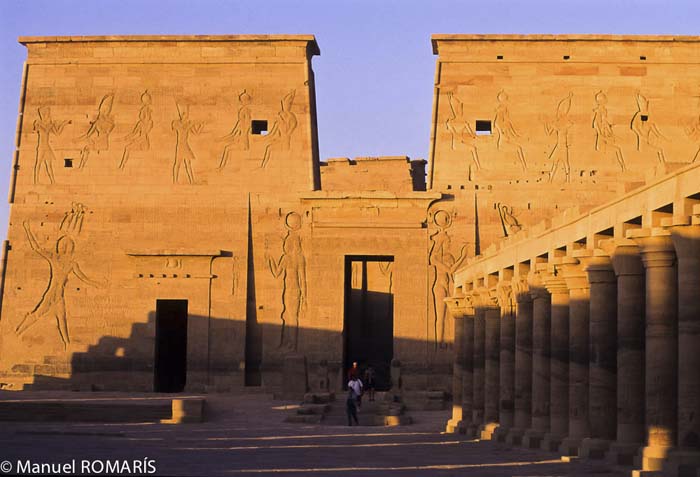
© Manuel ROMARÍS - Temple of Isis, Philae
The main features of this temple include:
Gate of Ptolemy II: Two pink granite lions stand in front of the first pylon by this gate. Two pink granite obelisks at one time joined the lions together. These obelisks are significant because the hieroglyphs found on the base of the obelisks were compared to the Rosetta stone, and were instrumental in deciphering the Egyptian consonantal alphabet.
First Pylon: Reliefs and inscriptions are abundant in the Temple of Isis. For example, on the eastern tower of the first pylon, Dionysus is depicted as holding the enemies of Egypt by the hair while raising his club. Others in the scene include Hathor, Horus and Isis. Above this menacing depiction there are two smaller scenes. One is of the pharaoh offering his crown to Horus and Nephtyhs, and one is of the pharaoh offering incense to Isis and Horus as a child.
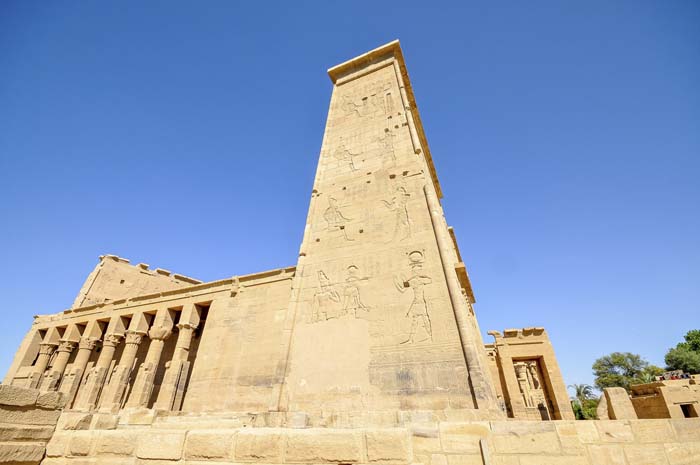
© Jorge Láscar - Side of the First Pylon and the forecourt of the temple
Birth House: A common feature in Ptolemaic temples, the Birth House in the Temple of Isis depicts Horus as a hawk wearing a double crown standing among papyrus. There is also a relief of Isis carrying a newborn Horus in her arms while being protected by Wadjet, Nekhbet, Amun-Ra and Thoth. Here, the king conducted rituals to validate his descendancy from Horus.
Second Pylon: The Western Tower depicts Ptolemy XII offering animals and incense to various gods including Hathor and Horus. Also depicted is the king offering flowers to Nephthys and Horus, and another of the king pouring water and presenting incense on an altar while in the presence of Horus, Isis and Osiris. A piece of granite along the Eastern Tower called a stele is carved of Ptolemy VI Philometor standing with Cleopatra II and Isis and Horus. The inscription is notable because it contains what is known as the grant of the Dodekaschoinoi, which lays claim to the land needed for the temple.
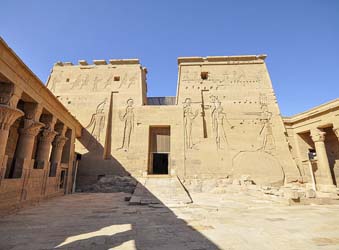
© Jorge Láscar - Second Pylon
Inner Courtyard: A Hypostyle hall stands through a gateway from the second pylon. Ten columns remain here and all are painted to look like and represent a variety of the first flowers and plants. The floor represented the primeval mound and the ceiling the sky, with images of the Day Boat (Madjet) and the Night Boat (Semektet).
Sanctuary: Through the Inner Courtyard is Isis’ Sanctuary. The actual sanctuary is a small chamber with two windows. A pedestal, placed here by Ptolemy III Euergetes I, remains today. It bears the image of Isis in her sacred barque (boat).
Nectanebo’s Kiosk
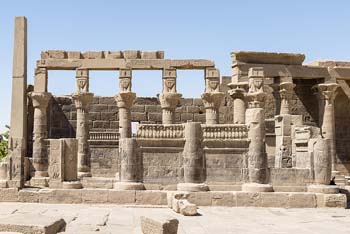
© kairoinfo4u - The Kiosk of Nectanebo I
Nectanebo’s Kiosk is a pillared, roofless hall that originally had 14 columns, of which six remain. The walls of this vestibule are decorated with reliefs of the king sacrificing various items to the gods. Screen walls of the Kiosk are connected by Hathor columns and topped with uraei (serpentine) carvings.
Temple of Hathor at Philae
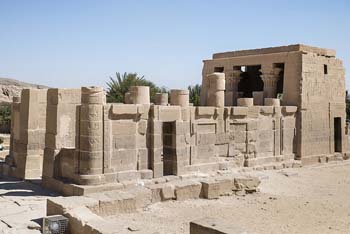
© kairoinfo4u - Temple of Hathor
Built by Ptolemy VI Philometor and Ptolemy VIII Euergetes II, the Temple of Hathor consists of a colonnade hall and a forecourt. Augustus decorated the hall to honor Isis and Hathor with depictions of festivals. Augustus is also depicted as presenting gifts to Isis and Nephthys. At The Temple of Hathor at Philae, the ancient Egyptians drank, ate and danced to music played by Bes (Dwarf God of humor, dancing and music) and his harp and tambourine.
Trajan’s Kiosk
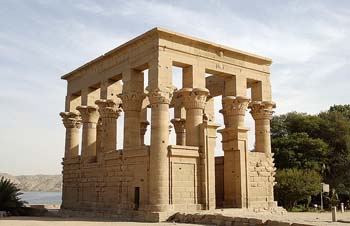
© Derek - Trajan's Kiosk at Philae
Considered by many to be the most appealing structure on Philae, Trajan’s Kiosk is today a roofless structure. In ancient Egyptian times, it was likely roofed and used as a shelter for Isis’ barque at the eastern banks. It is sometimes referred to as the “Pharaoh’s Bed”; Trajan was a Roman Emperor but the kiosk itself likely dates back to earlier times. It is heavily decorated with reliefs of Trajan burning incense to honor Osiris and Isis, while also offering wine to Isis and Horus.
Additional Structures on Philae
The island of Philae has much to offer with not just the Temple of Isis but also the Temple of Hoe-Anhur, and the Temple of Augustus. There are also chapels dedicated to Mandulis (the Sun God of Lower Nubia) and Imhotep (a commoner who achieved divine status after death, he was vizier to Djoser).
